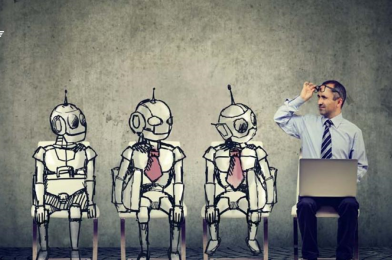In this article we are going to highlight the difference between two concepts that are often confused with each other. We talk about the differences between conversational bots and Artificial Intelligence.
They are two closely related terms, but in reality they are not at all synonymous. In fact there is a typology of conversational bots that does not rely on AI.
In fact, Artificial Intelligence is a step above, since it is not a tool but an advanced resource to enhance tools and procedures. We will explain this in more detail below.
THE USE OF ARTIFICIAL INTELLIGENCE IN CHATBOTS
To many people it still sounds like something out of science fiction, but Artificial Intelligence is something we all live with much more than we are aware of.
Every time we use something as everyday as an Internet search engine or type any text on our cell phone, we are making use of it in a completely transparent way. Connected devices “learn” from the way we use them, both personally and by extracting usage patterns based on different segments of the population (another very famous concept comes into play here: Big Data).
This, taken to user-machine interaction in the context of eCommerce, has one of its greatest exponents in conversational bots. Thanks to the use of technology, we can achieve advanced systems that provide solutions to increasingly complex queries using natural language and semantically interpreting the intention behind the user’s query.
Moreover, AI enhances an already existing tool, and does so by providing new strategic variants and functions. It directly turns chat into an ally when it comes to converting and closing sales. Undoubtedly, this is the real leap in quality with respect to those versions of bots that do not incorporate the use of Artificial Intelligence.
SO, ARE THERE CHATBOTS WITHOUT ARTIFICIAL INTELLIGENCE?
Yes, and it is something relatively frequent. If we understand as conversational bot a software that is able to interact with a user we can distinguish between the intelligent ones and the ones that use something called ITR (Interactive Text Response).
The latter allows us to configure the tool by setting a series of predefined responses that will be launched by the system according to the user’s questions.
The main difference with those bots operated through the use of Artificial Intelligence is that ITRs base all their effectiveness on what we are able to foresee and define previously. They do not have the ability to learn from the interaction or use the natural language of people, so they are less accurate.
ADVANTAGES OF CONVERSATIONAL BOTS WITHOUT IA
Do not make the mistake of assuming that by using a chatbot that does not incorporate AI, you are dealing with a necessarily basic tool.
On the contrary; if you are working with an advanced solution, the synergies and possibilities are practically endless. In fact, the chatbot does not have this technology, but through its connection via API it allows you to do amazing and really advanced things like tracking orders, displaying a map so that the customer can get directions to your physical store, showing recommendations in the chat co-viewer directly…
The implementation is very fast although it requires a detailed and deep analysis of the circumstances of use in which it is necessary.
This has the enormous advantage of working from the first moment exactly as well as 6 months later. Its effectiveness will always be the same and does not require a “running-in” time to evolve.
They can be somewhat cheaper, although not in all cases, and they do not represent a substantial difference with an AI-supported solution.
ADVANTAGES OF CONVERSATIONAL BOTS WITH IA
They are a living tool, capable of training itself. Thus, their effectiveness increases with the simple passage of time. What’s more, the higher the number of interactions, the better the decision making process.
If we are talking about highly complex technical systems, this is obvious, but one of the best things about these bots is that this is not transferred neither to the implementation nor to the day-to-day management.
The tool is less dependent. It could be used 100% autonomously, but even in cases where Artificial Intelligence is used, the human touch is always advisable for a matter of empathy and the ability to react accurately to new situations.
It also gives us the possibility to attend our public 24 hours a day, which is much more complicated if we need to have staff resources available all day long. We hope we have clarified the differences between conversational bots and Artificial Intelligence.


